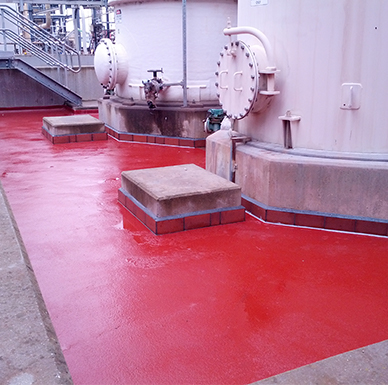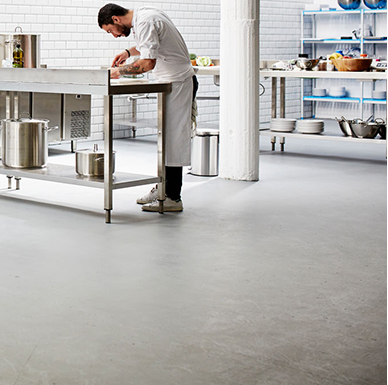Technical Bulletin No. 3
An epoxy resin is any compound which contains the reactive epoxide group![]() These epoxy groups in the resin can react by cross-linking with other compounds called hardeners or curing agents (amine or amide) to form rigid three-dimensional networks.
These epoxy groups in the resin can react by cross-linking with other compounds called hardeners or curing agents (amine or amide) to form rigid three-dimensional networks.
TYPES OF EPOXY RESINS (LIQUIDS)
Bisphenol A
Formed by the reaction of Bisphenol A and epichlorohydrin. Generally, the unmodified resin is quite viscous and is modified with diluents to reduce viscosity. This enables the resin to be used in flooring compounds.
Bisphenol A is the standard resin used in most epoxy compounds e.g. Metz 4HB, 19, 33 Series, 70 and Epoxy Primer liquids.
Epoxy Novolaco(also called epoxy phenol novolac)
Formed by reaction of phenol and formaldehyde. Have higher “functionality” than Bisphenol A resins (that is, more branching chains available for cross-linking with the hardener). These resins produce end products with higher cross-link density and therefore higher chemical and temperature resistance than Bisphenol A resins. They are also considerably more expensive.
The functionality of epoxy novolac resins increases with increasing molecular weight. This is accompanied by an increase in viscosity. The highest molecular weight resins are virtually solid at room temperature. Diluents must be added to reduce viscosity with a subsequent loss in properties. A balance must be struck between final properties, usability and cost.
Examples of epoxy novolac resins are Metz 6NF and 33EN Epoxy Novolac liquids
Types of Epoxy Curing Agents (Hardeners)
There are many types of compounds, which react with epoxy resins. The most common of these are aliphatic amines, cycloaliphatic polyamines and aromatic amines.
Each hardener imparts different properties to the end product. For example, Metz 19 Hardener imparts good chemical resistance and water-washability. Metz 33 Rapid hardener has low viscosity and light colour and impart improved chemical resistance and low temperature cure. Metz 6NF and 33EN Hardeners impart outstanding chemical resistance and rapid development of physical properties. Metz Epoxy Primer Hardener imparts moisture tolerance.
Again a balance must be struck between final properties, usability and cost. Metz 11E is the easiest product to use as it is water-washable in its uncured state, but does not have the chemical nor heat resistance of Metz 5NF which requires a solvent cleaner (Metz Cleaner). Metz 70 provides a balance between water washability and chemical resistance.
MIXING RATIO
The ratio between the resin (liquid) and curing agent (hardener) is critical to the performance of the final product. For every epoxy group in the resin there should be a corresponding active amine hydrogen group in the hardener i.e. the stoichiometric amount. The mixing ratio of every Metz epoxy product is worked out on this basis.
Different hardeners may have different active amine hydrogen contents and thus different mixing ratios with the same resin.
If the specified mixing ratio is altered, the properties of the final product will be decreased. Too little hardener means that not all epoxy groups will be cross-linked. Too much hardener means that there is excess hardener in the system, which generally migrates to the surface and can cause blooming, water spotting and other effects. It’s commonly referred as amine-blush or sweating.
One of the most frequent fallacies is that increasing the proportion of hardener will speed up the set. This is not the case. All that will happen is that the final properties will be reduced.
The methods that can be used for accelerating the set are:
a) Warming up the materials and/or the area
b) Using a different hardener
c) In some case, adding an accelerator. Contact Metz for details
Never alter the liquid/hardener ratio specified in the Data Sheet.
APPLICATION TEMPERATURE
The temperature at which an epoxy is applied and cured is also important to the performance of the product. As temperature decreases, the reactivity of epoxy systems decreases. The reactivity is dependent on the resin and hardener used. Metz 5NF is very reactive and can cure at temperatures down to 0oC. Metz 19 is not as reactive, and requires temperatures of above 10oC to cure completely.
Reactivity also relates to pot life. The more reactive systems have shorter pot lives. As a rule of thumb, every 10oC increase in temperature will halve the pot life and every 10oC decrease in temperature will double the pot life. The same factor will apply to curing time, with the proviso that every product will have a minimum curing temperature below which it will not cure completely.
Another factor that is often overlooked is the effect of temperature on the viscosity of the liquid and hardener. The viscosity of epoxy resin can vary quite markedly with temperature. At high temperatures, resins can flow almost like water. At low temperatures they can flow like treacle. These changes will have noticeable effects on how the product handles. If viscosities of the liquid and hardener are lower, the tendency will to be to add more filler, which may lead to a more porous product. If the viscosities are high, the tendency will be to add less filler, which will increase costs. High viscosities will also make the product more difficult to use.
FILLERS
Fillers are added to epoxy resin/hardener systems to enable them to be used for different purposes e.g. as grouts (Metz 11E and Metz 70) self-levelling compounds (Metz 33-SL) or trowel applied compounds (Metz 33-TG).
Fillers also have the effect of increasing compressive and flexural strength, decreasing the co-efficient of expansion and, of course, reducing cost.
OTHER POINTS
All Metz epoxy products, except 4HB and 5EN are virtually 100% solids. This means they do not contain non-reactive diluents or solvents. (They may contain small amounts of additives – for instance to improve flow or release air from the film). This means that the systems are totally reactive, which results in better physical properties and chemical resistance.
CONCLUSION
There are many different epoxy products that are formulated for specific conditions.
Bisphenol A Epoxies
(i) Grouts
Metz 19 is the standard water-washable epoxy grout suitable for most dilute chemical conditions e.g. food and beverage industry floors. Metz 11E for pool tile applications.
Metz 70 has higher chemical resistance than Metz 11E or 19 and is also water washable, but is slightly more difficult to use. Used in fast food kitchens.
Metz 17 is an epoxy adhesive for fixing ceramic tiles.
(ii) Coatings/Toppings
Metz 33 series has good chemical resistance and cures at low temperatures (down to 5oC). It is available in trowel grade (33-TG), self-levelling broadcast (33-SL Broadcast) and vertical grade (33-VG).
Metz 4HB is a formulated coating that can be applied without the need for a primer.
Epoxy Novolac
(i) Grouts
Metz 5NF and 6NF have outstanding chemical and temperature resistance. They are superior to the Bisphenol A epoxies especially in its resistance to concentrated acids.
Metz 5NFA is an accelerated version of 5NF and is used where fast setting is required.
(ii) Coatings/Toppings
Metz 4HB-EN: Epoxy Novolac coating
Metz 5EN: Sprayable version of 4HB-EN
Metz 33EN-TG: Trowel grade topping with the same excellent chemical resistance as 5NF. Also available in vertical grade – Metz 33EN-VG.
To obtain the best possible properties from epoxies:
– Always use the liquid to hardener mixing ratio specified on the Data Sheet.
– Observe the application and curing temperatures specified on the Data Sheet.
Note that epoxies are not suitable for all chemical, physical and temperature conditions.
Silicate cements (Metz 7K, 7KE, and Metz Sauereisen 65 and the 54 series) have superior resistance to concentrated acids, particularly organic acids. They also have much higher temperature resistance.
Furane resins (Metz 12P) offer more economical solutions in some cases, and have superior solvent resistance to most epoxies.
Vinyl ester resins (Metz 15VE and 16VE series) offer superior resistance to some oxidizing agents such as bleach solutions, and nitric acid.
Polyurethanes (Metz 94 and 93PU series) offer good resistance to organic chemicals, excellent temperature resistance and a coefficient of thermal experience similar to concrete.
Literally thousands of epoxy resin and hardener combinations are possible. Metz epoxies are formulated with a strong emphasis on meeting client performance requirements. There always needs to be a balance between final properties, ease of use and price. This is why Metz offers a comprehensive range of epoxy products.


